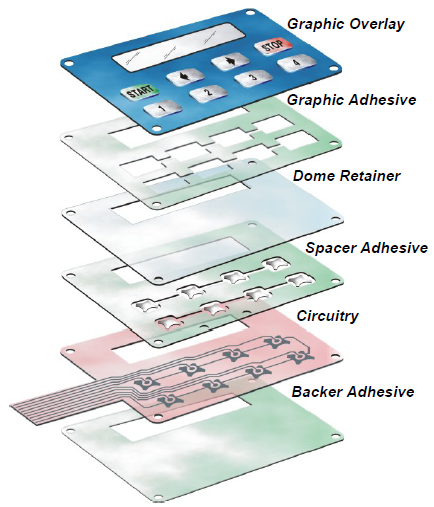Everything About Membrane Layer Switch: Understanding Its Style and Capability
When you think concerning the control user interfaces in modern-day gadgets, membrane layer buttons typically come to mind. Allow's explore what sets membrane switches over apart from various other control systems.
What Are Membrane Buttons?

Their seamless nature makes them very easy to tidy and immune to dust and moisture, a vital feature in several settings. Membrane switches can also be tailored regarding shape, dimension, and graphics, permitting suppliers to develop unique user interfaces tailored to details products. Plus, they're lightweight and slim, which helps in decreasing the general bulk of tools. On the whole, membrane layer switches play a substantial function in improving user experience throughout a wide selection of applications.
Exactly How Membrane Switches Over Job
When you press a secret on a membrane layer button, it turns on a simple yet effective system. membrane switch manufacturer. The leading layer, commonly made of flexible product, pushes down onto a conductive layer underneath it.
You'll observe that the responsive comments varies based upon the switch design, offering either a soft click or a much more pronounced feedback. When you launch the key, the membrane go back to its original placement, reopening the circuit and stopping the signal. This procedure happens nearly instantaneously, making sure a responsive user experience.
Membrane switches are popular due to their sturdiness and resistance to dust and wetness, making them excellent for different applications, from household home appliances to medical tools. Understanding this operation aids you value their extensive usage.
Key Parts of Membrane Layer Switches
Understanding the essential parts of membrane layer buttons is basic for understanding their capability and layout. The safety layer shields against environmental elements and put on, expanding the switch's life expectancy. By understanding these elements, you'll gain understanding right into how membrane layer switches run and their importance in numerous applications.
Materials Used in Membrane Switch Over Layout
The performance and sturdiness of membrane layer switches over greatly rely on the products made use of in their design. You generally run into polyester and polycarbonate as main substratums as a result of their outstanding toughness and versatility. These materials withstand scrapes and chemicals, making them perfect for requiring settings.
The conductive layers often make use of silver or carbon, chosen for their dependability and conductivity. membrane switch manufacturer. Silver gives superior performance, while carbon is a cost-efficient alternative. For the overlay, you might consider a matte or glossy surface, depending on your visual demands and individual experience
Make certain to select adhesives that stand up to environmental variables like temperature level and moisture. Selecting the appropriate materials will certainly assure your membrane layer switch stands the examination of time.
Design Factors To Consider for Membrane Switches
While creating membrane buttons, it's important to take into consideration numerous elements that affect their performance and individual experience. Begin by concentrating on the format and button size; ensure they're instinctive and easy to navigate. Think about the tactile responses you wish to give-- will individuals require a visible click or a softer touch? Furthermore, think of the materials you'll utilize, as they'll influence toughness and visual appeals.
Don't overlook the graphic design; clear labeling and color comparison are substantial for visibility. Validate your design accommodates ecological aspects, like wetness or temperature variations, which might impact efficiency. Keep in mind the relevance of testing models with genuine customers to gather feedback and make needed modifications. This repetitive process helps you fine-tune the design, verifying it meets both useful and aesthetic needs successfully. By meticulously considering these elements, you'll develop a membrane button that enhances functionality and contentment.
Applications of Membrane Switches
Membrane buttons are functional parts found in various applications, from industrial equipment to consumer electronic devices. You'll see their influence in equipments that call for durable interfaces and in tools that gain from smooth layouts. Understanding these applications assists you value the capability and functionality of membrane layer switches in everyday innovation.
Industrial Devices Use
When you're seeking to enhance the capability of industrial equipment, membrane buttons provide a trustworthy option that incorporates longevity with user-friendly design. These buttons are excellent for severe atmospheres, giving resistance to dirt, wetness, and chemicals. You'll locate them in control panels for manufacturing makers, HVAC systems, and clinical gadgets, where precision and responsiveness are essential. Their low profile implies they fit perfectly right into numerous devices, conserving valuable room while keeping convenience of use. With customizable graphics and backlighting options, you can create an user-friendly user interface for drivers, boosting efficiency and security. Plus, their lengthy life-span decreases upkeep costs, making them a smart financial investment for your industrial applications. Embrace membrane buttons to improve your operations and enhance general efficiency.
Consumer Electronics Combination
In the domain of consumer electronic devices, you can try these out membrane layer buttons play a necessary role in boosting customer communication and gadget performance. Membrane layer buttons likewise ensure sturdiness and resistance to dust and moisture, prolonging the life expectancy of your electronic devices. By picking membrane layer buttons, Visit Your URL you improve not simply the performance but additionally the style of your devices, making daily communications smooth and satisfying.
Advantages and Drawbacks of Membrane Buttons
While membrane switches supply a series of benefits, they additionally come with some drawbacks that you must think about. One significant advantage is their compact layout, making them ideal for space-constrained applications. They're additionally cost-effective, giving a long lasting service with a low manufacturing price. Additionally, their seamless surface is easy to clean, improving health in environments like hospitals.

However, there are disadvantages. Membrane buttons can have a much shorter life-span compared to mechanical switches, particularly under hefty use. They can likewise be less responsive, which may affect user responses during procedure. If damaged, repairing them can be challenging and often calls for complete replacement. Eventually, their sensitivity to severe temperature levels and ecological problems may restrict their effectiveness in specific setups. Balancing these pros and disadvantages will certainly aid you figure out if membrane buttons are the ideal fit for your job.
Regularly Asked Questions
How Much Time Do Membrane Changes Commonly Last?
Membrane layer switches over typically last between 5 to one decade, depending upon use and environmental problems. You'll intend to evaluate variables like wear, direct exposure to dampness, and temperature level changes to determine their durability successfully.
Can Membrane Layer Switches Over Be Custom-made for Particular Layouts?
Yes, you can tailor membrane buttons to fit specific styles (membrane switch manufacturer). You'll have the freedom to select shades, shapes, and designs that match your project's demands, ensuring they mix perfectly with your total visual
What Is the Cost Array for Membrane Change Manufacturing?
The Get the facts expense range for membrane layer button manufacturing normally falls between $1 and $10 per system, depending upon variables like design complexity, amount, and materials. You can get quotes from makers to discover the very best choice.

Are Membrane Layer Switches Over Water Resistant or Immune?
Membrane buttons can be developed to be water resistant or immune, depending on products utilized and construction techniques. If you require them for wet atmospheres, guarantee you define those demands during the design process.
How Do Membrane Layer Switches Compare to Standard Buttons?
Membrane switches are usually thinner and much more flexible than standard buttons, supplying a smooth layout. They're usually simpler to clean up and integrate, but may not supply the tactile comments you're used to with mechanical options.
Conclusion
